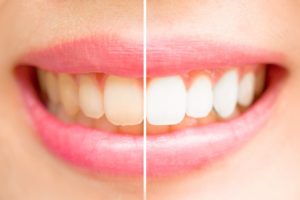 After work you head to the local pharmacy to pick up some toothpaste. You just ran out and are considering a change of pace for your oral regimen. As you walk down the aisle, you find a brand that contains teeth-whitening agents designed to remove stains.
After work you head to the local pharmacy to pick up some toothpaste. You just ran out and are considering a change of pace for your oral regimen. As you walk down the aisle, you find a brand that contains teeth-whitening agents designed to remove stains.
You wonder, “How well does it work? Is it even worth it?” In a new blog post, your dentist discusses the effects toothpaste with whitening agents have and what alternatives currently exist that can do better.
What is Teeth-Whitening Toothpaste Designed For?
Standard stains caused by smoking or foods like soda, coffee, and wine can be removed with teeth-whitening toothpaste. This form of whitening creates an appearance of whiter teeth before stains permanently set into your porous teeth. However, it can take 2 to 6 weeks for your teeth to become noticeably whiter.
If you’re looking for an immediate solution to yellow teeth, look for toothpaste containing blue covarine. While this method doesn’t create results as long-lasting as other methods of teeth-whitening, blue covarine diminishes the yellow appearance on the surface of your tooth right away. Be sure to spend time comparing the active ingredients in toothpaste to discover the right choice for you.
What to Look for in Teeth-Whitening Toothpastes
While reading the ingredients on teeth-whitening toothpaste products, you’ll likely see these abrasives and bleaching agents on the label:
- Hydrated aluminum oxide (abrasive)
- Calcium carbonate (abrasive)
- Magnesium carbonate (abrasive)
- Carbamide peroxide and Hydrogen Peroxide (bleaching agents)
Furthermore, look for the American Dental Association’s Seal of Acceptance on the back to ensure it’s safe to use. Products with this seal have undergone thorough evaluation and demonstrate safety and efficacy.
Keep in mind, even if these toothpastes carry the ADA Seal, it doesn’t mean that teeth-whitening products don’t carry risks. Because these whitening agents are abrasive, side effects like mild irritation of the gums/mouth and tooth sensitivity can occur. Your tooth’s enamel could also be worn down unintentionally. To avoid this, you’ll want to look at alternative whitening methods that don’t cause these side effects.
What’s the Better Alternative for Whiter Teeth?
Dentists hear it all the time. A patient comes in for their checkup and mentions how over-the-counter methods of teeth-whitening don’t give them the pearly-white smile they expected. That’s why many dental offices offer 1-hour, in-office, teeth-whitening treatments and take-home kits.
These treatments contain much higher concentrations of active bleaching ingredients. For example, over-the-counter treatments contain 10 percent of carbamide peroxide, while a professional grade applications contain between 25 and 40 percent of hydrogen peroxide. Protective gel is also used on the gums to prevent irritation when using these treatments. Toothpastes just can’t compare in terms of effectiveness for whitening your teeth.
Toothpaste shouldn’t be your only method for whiter teeth. Schedule a visit with your dentist today to find the best treatment for you!
About the Author
Dr. James A. Moreau Jr., DDS, graduated from the L.S.U. School of Dentistry and served as an associate professor of Fixed Prosthodontics at dental school for seven years. With decades of experience in full-mouth reconstruction, smile makeovers, and advanced restorative care, he’s fully prepared to provide treatments meant to transform your smile. To learn more about his practice and teeth-whitening treatments, contact him at (985) 809-7645 or visit his website.
